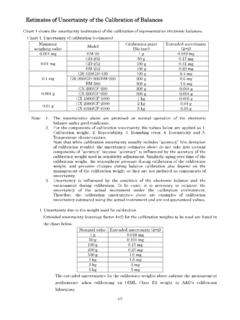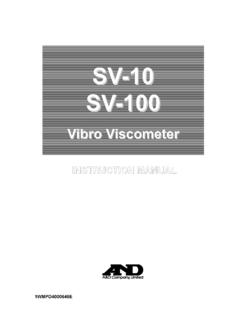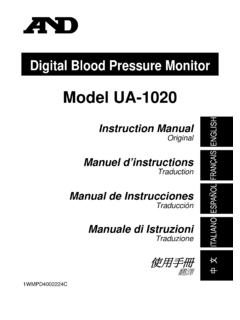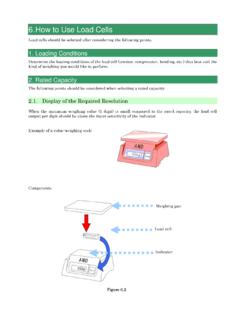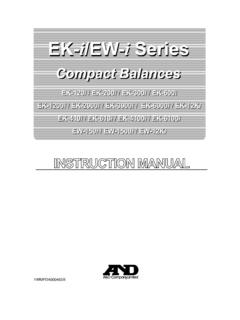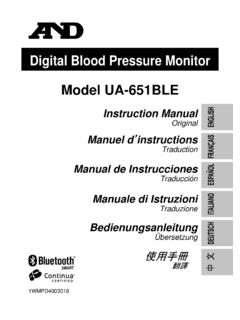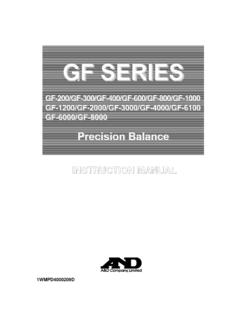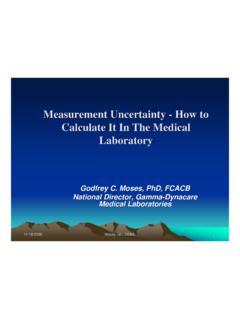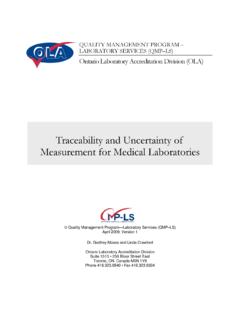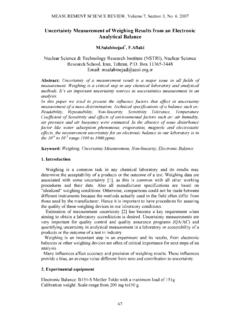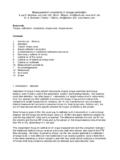Transcription of Estimates of Uncertainty of the Calibration of …
1 1/7 Estimates of Uncertainty of the Calibration of Balances Chart 1 shows the Uncertainty ( Estimates ) of the Calibration of representative electronic balances. Chart 1. Uncertainty of Calibration ( Estimates ) Minimum weighing value Model Calibration point (No tare) Extended Uncertainty (k=2) mg BM-20 1 g mg GH-202 50 g mg GH-252 100 g mg mg BM-252 100 g mg GR-120/GH-120 100 g mg GR-200/GH-200/BM-200200 g mg mg BM-500 500 g mg GX-200/GF-200 200 g g GX-600/GF-600 500 g g g GX-1000/GF-1000 1 kg g GX-2000/GF-2000 2 kg g g GX-6100/GF-6100 5 kg g Note: 1. The uncertainties above are premised on normal operation of the electronic balance under good conditions. 2. For the components of Calibration Uncertainty , the values below are applied as 1. Calibration weight, 2. Repeatability, 3. Rounding error, 4. Eccentricity and 5. Temperature characteristics.
2 Note that while Calibration Uncertainty usually includes accuracy (the deviation of Calibration results), the Uncertainty Estimates above do not take into account components of accuracy because accuracy is influenced by the accuracy of the Calibration weight used in sensitivity adjustment. Similarly, aging over time of the Calibration weight, the atmospheric pressure during Calibration of the Calibration weight, and pressure changes during balance Calibration also depend on the management of the Calibration weight so they are not included as components of Uncertainty . 3. Uncertainty is influenced by the condition of the electronic balance and the environment during Calibration . To be exact, it is necessary to estimate the Uncertainty of the actual instrument under the Calibration environment.
3 Therefore, the Calibration uncertainties above are examples of Calibration Uncertainty estimated using the actual instrument and are not guaranteed values. 1. Uncertainty due to the weight used for Calibration Extended Uncertainty (coverage factor k=2) for the Calibration weights to be used are listed in the chart below. Nominal value Extended Uncertainty (k=2) 1 g mg 50 g mg 100 g mg 200 g mg 500 g mg 1 kg mg 2 kg 3 mg 5 kg 5 mg The extended uncertainties for the Calibration weights above indicate the measurement performance when calibrating an OIML Class E2 weight in A&D s Calibration laboratory. 2/7 2. Uncertainty due to repeatability Use the catalog specifications (reproducibility) of each balance. 3. Uncertainty due to rounding error Calculate from the minimum display value of the relevant balance. 4. Uncertainty due to eccentricity Calculate from the specifications at the time the relevant balance was manufactured.
4 5. Uncertainty due to temperature characteristics Calculate based on the catalog specifications (sensitivity drift) of the relevant balance with the temperature change during Calibration set within 2 C. Example of Calculating the Uncertainty of Balance Calibration 1. Introduction In this example, the actual Uncertainty of balance Calibration for a GR-200 is calculated. GR-200 specifications Capacity :Max 210 g Minimum weighing value (scale interval) :d mg The components of Uncertainty during Calibration include the following items. 1-1 Uncertainty due to the Calibration weight 1-2 Uncertainty due to the Calibration work 1. Repeatability 2. Eccentricity 3. Accuracy 1-3 Other causes of Uncertainty 1. Temperature characteristics 2.
5 Rounding error 2. Preparation While referring to the operation manual, set up the balance in an appropriate location, and then warm up the balance for the specified time. (Leave the power on.) 3. Sensitivity adjustment Adjust the sensitivity before Calibration if necessary. If the sensitivity is adjusted, note this fact in the Calibration results as a condition of Calibration . 4. Repeatability As an example, the following procedure shows how to measure repeatability with a test load of 200 g, 3/7 which is equal to or greater than (Capacity ). Measurement is performed six times. 1. Reset the balance to zero, and then confirm that the indicator value is zero. 2. Load a weight equivalent to the test load on the center of the pan, and then record the indicator value. 3. Remove the weight. Repeat steps 1 to 3 six times. Example measurement results Measurement order i 1 2 3 4 5 6 Indicator value iI g g g g g gAverage value I g II i mg mg mg mg mg mg From these results, use the following formula to calculate the dispersion (Vr) due to repeatability.
6 22)n1ii(1n1r IISV 23mg .. (1) 5. Eccentricity As an example, the following procedure shows how to measure eccentricity of a test load (P) of a 100 g, which is equal to or greater than 1. Before measurement, reset the balance to zero, and then confirm that the indicator value is zero. 2. Load a 100 g weight, which is equivalent to the test load, on the center of the pan (position 1), and then record the indicator value I1. 3. Place the same weight at position 2, and then record the indicator value I2. 4. Place the same weight at positions 3, 4, and 5 in turn, while recording the respective indicator values I3, I4, and I5. Here, I is the average of theindicator values Positions 2 to 5 are in the centers of the quarters (1) (5) (4) (3) (2) For a square weighing pan(1)(5)(4)(3)(2)For a round weighing pan 4/7 Example measurement results Measurement order i 1 2 3 4 5 Measurement position (1) (2) (3) (4) (5) Indicator value Ii g g g g gDifference from center mg mg mg mg From the results, calculate E1 (the eccentricity standardized to a test load of Max/3) from the difference E(the maximum difference for center loading and eccentric loading).
7 If Max (capacity) = 210 g, P (test load) = 100 g, and E = mg (from the eccentricity measurement above) are substituted, the following value results. E1= mg 210 g/300 g= mg Ve (the relative dispersion of the eccentricity) is presumed to have a uniform distribution with a maximum of E ( E). 2222) (31)1()31(ee MaxEUV .. (2) 6. Accuracy As an example, accuracy is measured using test loads, including those with and without tare loads, of the following weights. Weight type Use Nominal value Conventional mass Extended Uncertainty U(k=2) Dispersion of Uncertainty of Calibration weight Vs W1 Calibration 200 g 200 g+ mg 10-2mg2 W2 Calibration 50 g 50 mg mg 10-3mg2 T1 Tare load 50 g T2 Tare load 100 g T3 Tare load 150 g Note: It is acceptable for the 150 g for T3 to be comprised of T1 and T2.
8 Based on coverage factor k=2, calculate Vs (the dispersion of Uncertainty of Calibration weight) using the following formula. Vs = (U/2)2 1. Before measurement, reset the balance to zero. Check that the indicator value is zero, load Calibration weight W1 at the center of the pan, and then record the indicator value I1. Next, remove the weight. 2. As in step 1, load Calibration weight W2, and then record indicator value I2. 3. Load weight T1 as the tare load weight, and then take tare. Check that the indicator value is zero, place Calibration weight W2 at the center of the pan, and then record the indicator value I3. Next, remove the weight. 4. As with Step 3, load Calibration weight T2 as the tare load, and then record indicator value I4 for Max 3P E1= E 5/7 Calibration weight W2. 5. As with Step 3, load Calibration weight T3 as the tare load, and then record indicator value I5 for Calibration weight W2.
9 Example test loads and measurement results Measurement order i 1 2 3 4 5 Tare load 0 g 0 g 50 g 100 g 150 g Weight for tare - - T1 T2 T3 Calibration weight W1 W2 W2 W2 W2 Calibration weight value g g g gIndicator value Ii g gDeviation mg mg mg mg mg 7. Temperature characteristics Establish the temperature change ( T) during balance Calibration as follows. For the temperature range, a uniform distribution with a maximum of T21 is assumed. For the temperature characteristics value TK (sensitivity drift), calculate the relative dispersion (Vt) of the temperature characteristics using the following formula based on the specifications of the balance. T =2 C .. Establish the temperature change during balance Calibration as 2 C. TK=2ppm/ C .. Balance specification 222)(121)32(ttTK TTK TUV )C2ppmC2(121 .. (3) 8. Rounding error The Uncertainty for the resolution (scale interval d) of the display is assumed to be the uniform distribution with a maximum of d/2.
10 This assumption is based on the following formula using the zero point before measurement and the measurement values. 222612)32(ddddUV 232mg .. (4) 9. Extended Uncertainty Use the following formula to calculate the extended Uncertainty U (coverage factor k=2) at each measurement point in 6. Accuracy . 6/7 VkWVWVVVVkU ]itiesdr[22 The items to substitute are listed below. Vr: The repeatability dispersion. Substitute the calculation result (1) of 4. Repeatability . Vd: The rounding error dispersion. Substitute the calculation result (4) of 8. Rounding error . Vs: The Calibration weight Uncertainty dispersion. Calculate from the Calibration weight Uncertainty used in the measurement of 6. Accuracy . (See 6. Accuracy.) Ve: The relative dispersion of the eccentricity. Substitute the calculation result of "5.
